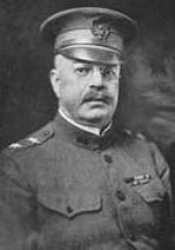
 |
|
|
||
|
Joseph Theodore Dickman |
||||
|
Graduate, U.S. Military Academy, Class of 1881 Engagements: • Indian Wars (1775 - 1924) intermittent• Spanish-American War (1898)• Boxer Rebellion (1899 - 1901)• World War I (1914 - 1918) |
||||
| Biography: | ||||
|
Joseph Theodore Dickman Joseph Theodore Dickman was born on 6 October 1857 in Dayton, OH. He attended the University of Dayton and graduated in the class of 1871. In 1881 he graduated from the U.S. Military Academy at West Point and was commissioned as a Second Lieutenant in the 3rd Cavalry. Apache Wars and Border Duty 1883-1898 Dickman graduated from the U.S. Army Cavalry School in 1883 and proceeded directly to the Indian territory, where he participated in the Apache War from 1885-86, to include the Geronimo Campaign. He next participated in the Mexican border patrol operations against Garza revolutionists and the bandits, Benavides and Gonzales. His early experience sent him to Fort Riley, KS, where he was an Instructor at the Cavalry and Light Artillery School from 1893-94. He deployed to the Chicago railroad strike in 1894. Later that year, he was assigned to Fort Ethan Allen, VT. Spanish-American War 1898-1900 Dickman's deployment during the Spanish-American War was notable. He participated in the battle of San Juan Hill-El Caney, Santiago de Cuba. He served on the staff of General Joseph Wheeler at the Battles on the Island of Panay from 1899-1900 and during the Philippine-American War from 1899-1902. Boxer Rebellion 1900 During the Boxer Rebellion, Dickman was Chief of Staff to General Adna R. Chaffee for the Peking Relief Expedition and fought in the battle at Pa-ta-Chao, Peking on 26 September 1900. 1902-1917 Dickman was on the Army General Staff from 1902-05. He was an Instructor at the Army War College from 1905-12. Dickman was the US Army Inspector General from 1912-15, taking over 2nd US Cavalry in 1915. He was given command of the 85th Infantry Division, Camp Custer, MI, in August 1917. World War I 1917-1918 Commanding General, 3rd Infantry Division Dickman was given command of the 3rd Infantry Division in November 1917, at the onset of World War I. He deployed 3rd Division to France aboard the USS Leviathan at noon on 4 March 1918. He was the 3rd Division Commander at Chateau-Thierry in May 1918 and was made famous at the Second Battle of the Marne in July 1918. While allied forces on both flanks retreated, the 3rd Division stood fast in the face of fantastic enemy offensives, which led to their moniker, "The Rock of the Marne." Commanding General, IV Corps Dickman commanded IV Corps from August to September 1918, to include the Saint-Mihiel Offensive in September 1918. Commanding General, I Corps Dickman commanded I Corps from October to November 1918, to include the Meuse-Argonne Offensive. Commanding General, Third Army, November 1918-April 1919 Third Army was established under the command of Dickman by General John J. Pershing in France to advance to the Rhine and hold the Coblenz bridgehead, and then prepare to serve after the war as the Army of Occupation of the Rhineland. The Third Army would have become the Army of Occupation whether or not the enemy signed the peace agreement. American fighting units not sent home were consolidated under Third Army and prepared to attack if Germany did not accept the terms of peace. The U.S. itself was not to sign the agreement but remained technically at war with Germany for two more years. 1919-1927 Dickman returned from World War I to serve as President of the Tactics and Organization Board, which reported on lessons learned during the war from April-July 1919. Dickman served as Commanding General of the VIII Corps Area from 1919-21. He retired from active service as a Major General on 6 October 1921. He was later recalled to preside over postwar-Army downsizing board in 1922. In Retirement His memoirs were published in 1927. Medals and Awards Distinguished Service Medal Honors The honorary degree of LL.D. was conferred on him by the University of Vermont. The USS Joseph T. Dickman (APA-13) was one of the three largest attack transports in the Amphibian Force during World War II. She carried 35 landing boats and 2 tank lighters, along with 51 officers and a crew of 634. This newly-commissioned U.S. Navy vessel was operated by the U.S. Coast Guard. The USS Joseph T. Dickman carried soldiers of the 4th Infantry to the beaches of Normandy during Operation Overlord on D-Day. The Dickman Rifles The famous National Society of Pershing Rifles had its origin in 1894, when future General John J. "Black Jack" Pershing, then a Second Lieutenant in charge of military instruction at the University of Nebraska, started a "Varsity Rifles" drill team. A year later the unit was recognized as a fraternity and took on the formal name of "Pershing Rifles." Similarly, the Dickman Rifles was an honorary military society formed at the University of Dayton to honor Major General Joseph T. Dickman, Class of 1871. In May 1931 the Dickman Rifles were invited to a Pershing Rifles drill competition. This exposure to the National Society of Pershing Rifles led to a petition from the members to join the National Society. Death and Burial Major General Joseph Theodore Dickman died on 23 October 1927 in Washington, DC. He is buried at Arlington National Cemetery in Arlington, VA. |
||||
| Honoree ID: 2427 | Created by: MHOH | |||
Ribbons
Medals
Badges
Honoree Photos
 |  |  |
 |  |
 |


